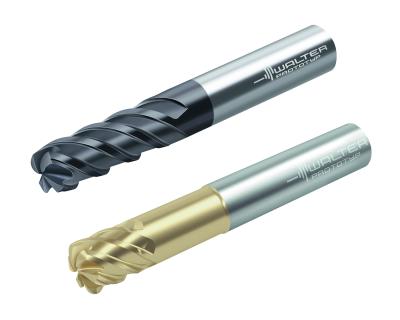
Walter has introduced the MC025 Advance and MD025 Supreme solid carbide milling cutters. Both high-speed, high-feed milling cutters feature exceptional process reliability thanks to their high-feed face geometry and low radial load. In addition, the MC025 and MD025 cutters are available with cylindrical shank or ConeFit head systems.
The MC025 Advance is available in diameters from 1/8-1 in. (1-25 mm). A single grade is offered for universal applications for steel, stainless steel, cast iron and materials with difficult cutting properties as well as its ability to lower inventory costs. It has a long peripheral cutting edge for good chip removal and for providing support when machining walls. It excels at near net-shape roughing with high feeds per tooth at low depth of cut, and successfully tackles pocket, groove, and freeform surfaces. The MC025 cutter is finding acceptance in the die and mold industry as well as general metalworking.
The MD025 Supreme solid carbide milling cutter boasts a high number of teeth for maximum productivity and high-feed face geometry. It is ideal for use on complex components.
The MD025 enables near net roughing with high feeds per tooth at low depth of cut, provides for a short and stable peripheral cutting edge, and like the MC025 successfully tackles pocket, groove, and freeform surfaces. Available in diameters from 1/4-1 in. (6-25 mm), the Walter MD025 is offered in two separate grades to customize the application whether machining carbon steel, stainless or materials with difficult cutting properties. Both grades are suitable for use in the die and mold industry as well as the medical technology, energy, and aerospace industries.
There are three designations to Walter product technology—Perform, Advance andSupreme. The Perform tools provide an economical solution with focused importance on price. The Advance tools are efficiently balanced between price and performance. The Supreme designation indicates the highest level of technology and performance available.
Contact Details
Related Glossary Terms
- depth of cut
depth of cut
Distance between the bottom of the cut and the uncut surface of the workpiece, measured in a direction at right angles to the machined surface of the workpiece.
- gang cutting ( milling)
gang cutting ( milling)
Machining with several cutters mounted on a single arbor, generally for simultaneous cutting.
- metalworking
metalworking
Any manufacturing process in which metal is processed or machined such that the workpiece is given a new shape. Broadly defined, the term includes processes such as design and layout, heat-treating, material handling and inspection.
- milling
milling
Machining operation in which metal or other material is removed by applying power to a rotating cutter. In vertical milling, the cutting tool is mounted vertically on the spindle. In horizontal milling, the cutting tool is mounted horizontally, either directly on the spindle or on an arbor. Horizontal milling is further broken down into conventional milling, where the cutter rotates opposite the direction of feed, or “up” into the workpiece; and climb milling, where the cutter rotates in the direction of feed, or “down” into the workpiece. Milling operations include plane or surface milling, endmilling, facemilling, angle milling, form milling and profiling.
- milling cutter
milling cutter
Loosely, any milling tool. Horizontal cutters take the form of plain milling cutters, plain spiral-tooth cutters, helical cutters, side-milling cutters, staggered-tooth side-milling cutters, facemilling cutters, angular cutters, double-angle cutters, convex and concave form-milling cutters, straddle-sprocket cutters, spur-gear cutters, corner-rounding cutters and slitting saws. Vertical cutters use shank-mounted cutting tools, including endmills, T-slot cutters, Woodruff keyseat cutters and dovetail cutters; these may also be used on horizontal mills. See milling.
- shank
shank
Main body of a tool; the portion of a drill or similar end-held tool that fits into a collet, chuck or similar mounting device.

